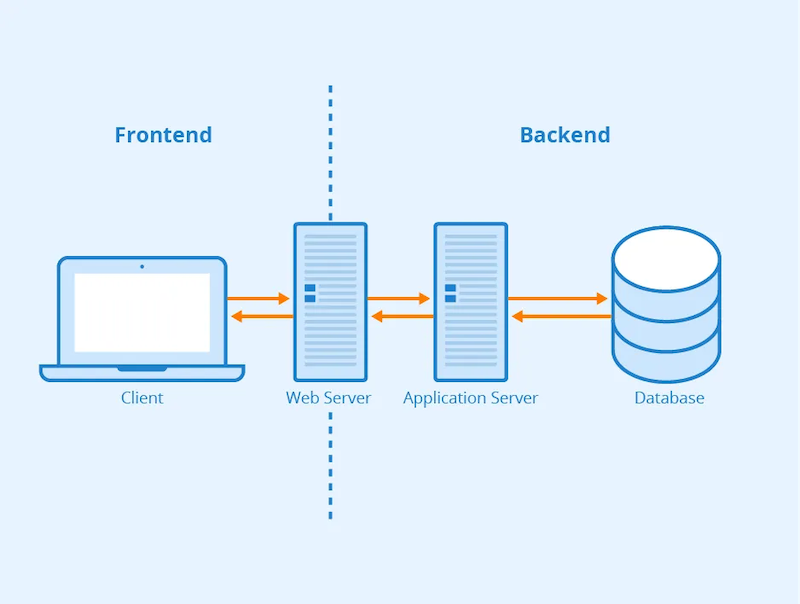
Clear Backend Definition and its Detailed Characteristics
The backend and frontend are two different parts of a website in charge of separate tasks. The frontend - user interface - is responsible for how the application looks and how the user interacts with it. The backend is part of the system that includes business logic, data processing, and communication with various systems. It’s therefore the basis of the application, which allows it to process information and send it to the frontend.
What is a backend?
The backend, otherwise known as the "server part of the application," is part of the system that isn’t visible to the user, but still plays an essential role in the operation of the application. According to the backend definition, it also oversees the processing of data and its appropriate distribution, giving logic and more interaction with our application.
To see an example of using the backend we can take a look at an online store. The frontend allows the user to browse products, select variants, and impacts the appearance of our store. The backend plays an important role in this process, as it’s the one that provides product data, saves new orders in the database, and ensures payment security. It’s also responsible for many other processes that the user doesn’t even notice when placing an order.

Source: Medium.com
Unlike the frontend, the backend focuses on the operation of the application and the disposition of information. It plays a key role in applications, so its tasks and role should be clearly defined when planning a website or application.
Why is a backend an important part of the system?
For complex applications, displaying static data isn’t enough. The backend allows you to create dynamic pages that adjust the data based on the written code. Although the backend is a part of the system that is invisible to the user, its functions are essential for the proper operation of the application.
Going back to the online store example – without using a backend, the shop would be just a product catalog, where changing any description or image would require HTML knowledge. When a user wants to place an order, it’s the server part of the application that takes care of creating the order in the database and handling the payment securely.
The backend also plays an essential role in website security. It has access to the database, where sensitive user data is often stored. To ensure security, the backend should implement various security methods, such as data encryption, user authentication, or data access restriction.
The importance of the backend for web development
The backend has many uses in modern websites. The main applications include:
- Data and business logic. The backend is responsible for processing user input and maintaining the application's business logic, allowing the system to operate correctly and as predicted.
- Communication with databases. Websites save thousands of data that are stored in a database. Accessing and modifying this data are the tasks of the backend.
- Scaling. Tailored code architecture allows the application to scale to adapt to the growing traffic, which allows for avoiding crashes and ensuring website reliability.
- Data analysis. The backend allows for processing data extracted from the application and using it to make business decisions.
- Integration with other systems. The backend authorizes you to integrate your application with other systems, such as payment systems or CRMs.
- API management. The backend enables managing the API, sharing data from the website with other applications, and controling access to the data.
Backend languages
Many programming languages can be used for backend development. Below are some examples of backend languages and their purposes.
PHP
This language is particularly popular for creating dynamic websites and web applications. It’s often used in conjunction with MySQL databases. PHP is also widespread in the ecommerce industry – many popular solutions for online stores are written in this language (such as Drupal Commerce).
Java
One of the most popular programming languages that are often used for backend development. It’s a general-purpose language because it’s versatile and allows you to create both simple and complex applications.
Python
This language is easy to operate. That’s why it’s often used to develop web applications and automate work.
C#
It’s a programming language often used to develop desktop and web applications using the .NET Framework. C# is very similar to Java and is popular in industries such as games and business applications.
The choice of language for backend development depends on the project needs and the developers’ preferences, but each of the mentioned languages is capable of handling backend tasks.
Backend system
What is a backend system? It’s a set of tools and technologies that are used to create and maintain a backend infrastructure. It consists of several vital components, such as:
- Server – the fundamental element of the backend system, responsible for storing and processing code or information.
- Database – another important component of the backend system, which task is to store and share data. Databases can be relational or NoSQL.
- Framework – a set of tools that facilitate the development of backend applications. Frameworks provide ready-made solutions for application development, which reduces the time needed to build applications.
- Programming language – a tool used to write backend code. The choice of programming language depends on the needs of the project.
- Management tools – elements of the backend system that allow you to manage the application, such as data monitoring and analysis tools, testing tools, or code version management tools.
Choosing the right system components is crucial at the application design level. Well-matched tools and solutions will save the time needed to complete the project and positively affect the performance and security of the website.
Backend architecture
A backend architecture is a set of principles and practices that define how a backend should be built and managed. The goal of backend architecture is to ensure the performance, scalability, security, and reliability of the application.
There are many different backend architectures, but the most popular are:
- Monolithic architecture – the simplest backend architecture, in which all application functions are located in a single module. It’s easy to implement, but difficult to develop and scale.
- Microservices architecture – an architecture, in which the application is divided into several independent microservices (small pieces of code that are responsible for different functionalities). This solution is more challenging to implement, but easier to develop and scale.
- Cloud architecture – an architecture, in which an application is hosted in the cloud and benefits from cloud resources such as scalability, reliability and security. This model allows the application to be flexible and scale as needed.
- Serverless architecture – an architecture in which the application is hosted in the cloud and uses serverless services such as AWS Lambda, Azure Functions, or Google Cloud Functions. This model isn’t complicated to use, and it saves costs and scales only when needed.
Choosing the right backend architecture depends on the application requirements and business needs. It's always worth considering all options and consulting with web development experts to choose the best architecture for a given project.
Backend database
Databases are essential components of web applications that allow you to store, organize and share data. They are used to store information, such as data about users, products, orders, or transactions. They can also make them available to other parts of the system or users.
There are two main types of databases – relational and NoSQL:
- Relational databases store data in tables and allow relationships between them. Examples of relational databases include MySQL, PostgreSQL, and Oracle.
- NoSQL databases store data in a different format than tables and don’t allow relationships between them. Examples of NoSQL databases are MongoDB and Redis.
Databases also enable searching, sorting, and filtering data, as well as updating and deleting it.
Backend definition – summary
The backend definition reflects that it’s certainly a key part of modern websites. It allows you to create a dynamic page that will reflect the business logic of the project.
At our Drupal agency, we handle both frontend and backend development. We’ll help you choose the most suitable language, system, architecture, and database, as well as implement all these elements into your application.











